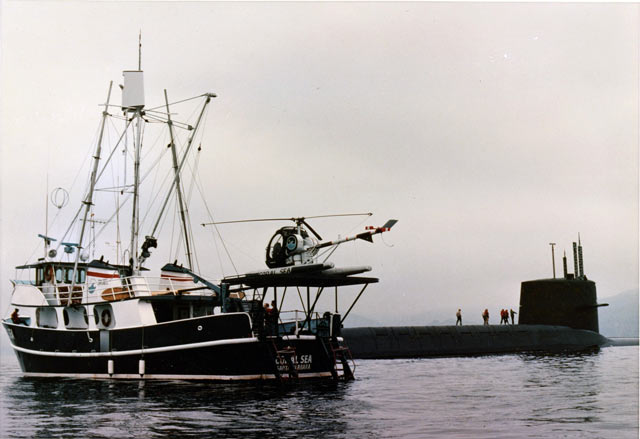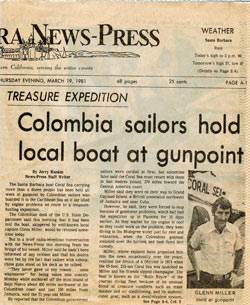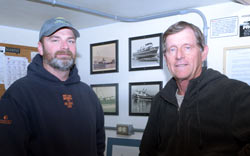
A science laboratory for HSU students since 1998, the boat could also teach a history lesson. Its current captain, Scott Martin, is delving deeper into the Coral Sea’s colorful past, inspired by a phone call he received in January from a relative of its builder and original captain.
“(The caller) had found a lot of information about the boat when he and his wife were going through his mother-in-law’s possessions after she had died,” Martin said. “He wanted to know if I was interested in it, and I said, ‘absolutely.’”

In late January, Martin received a box containing newspaper clippings, books, photographs and 8mm film, all evidence of the Coral Sea’s early history. Martin has eagerly studied the artifacts, and plans to pursue more information on its colorful past.
“Every captain wants to know as much as possible about his boat’s history,” Martin said. “We’ve gone all through the boat now, and knowing how it has been used before helps understand how it is set up. It’s all starting to make sense.”
Built in Santa Barbara, Calif., in 1974, the then 85-foot Coral Sea carried its owner and captain, Glenn Miller, on adventures from the Channel Islands to the Caribbean. Joining Miller on board was his springer spaniel, Mac, who was marketed by his owner as the world’s first diving dog.
Pursuing his diving interests while dabbling in the entertainment industry, Miller tried to make a star out of Mac. He fitted the springer spaniel with swimming goggles, attached weights and tossed him in the sea. Mac – known by crewmembers as a sandwich-stealing, foul-smelling beast – would walk across the ocean bottom, performing for any interested audience.

Miller outfitted the Coral Sea for luxury so it could live up to its marketing as the “Rolls Royce” of the charter diving business. Its cabin was air -conditioned, it had a helicopter pad, and housed sophisticated equipment, including a desalinization system.
In 1979, Hayward-based dive shop owner Margaret Brandeis chartered the Coral Sea for a treasure-hunting expedition. Along with Miller, a two-man crew that included his son, Zach, and a group of investors, Brandeis sailed away on a yearlong odyssey.
It didn’t take long before the excitement began. Having drifted into disputed territorial waters off the coast of Columbia, Miller, his crew and passengers were surprised when a Columbian navy ship approached. Miller acted quickly, tossing overboard the $10,000 black market anti-tank weapon he had purchased to defend the boat against pirate attacks.
Seized by heavily-armed Columbian sailors, the Coral Sea and its crew spent the next six days in port on the island of San Andreas, which at the time was claimed by both Columbia and Nicaragua. They were finally freed and allowed to keep the boat, which had been stripped of much of its equipment.
Miller and Brandeis were undeterred by the side trip, taking the boat to the Bahamas, where they encountered pirates that had moved in to the leased site ahead of them. After forcing the pirates out of the area, the treasure hunters immediately found silver bars, gems and gold doubloons left behind when the Spanish Galleon, Maravilla, sank off Little Bahama Bank in 1656.
After spending nearly a year combing the sea floor, Brandeis and her team eventually gave up on finding the contents of the main cargo hold, which had cracked open like an egg, spreading its loot across miles of ocean. They had found just enough treasure to break even after all expenses were paid.
“The bottom line on the treasure hunt is that the people involved got a lot of great tax write-offs,” Zach Miller said in a Santa Barbara News Press article published on May 25, 1987.
While Zach captained the Coral Sea on charters out of Ft. Lauderdale, Fla., Glenn took a break from the sea, traveling to Arizona to work as a helicopter pilot on the set of a TV movie, “Deadly Encounter.” At the end of shooting one day, Miller took off from the Grand Canyon staging area, heading to Lees Ferry along with three other support staff members. Officials later theorized that he never saw the cable that stretched across the canyon, clipping it with the machine’s tail section to send the helicopter skipping across the Colorado River.
The accident was the final adventure for Miller, who was 52 years old when the crash took his life. Also killed were Diane Dougherty, 27, and Frank Novak, 49. Lori Lee Gere, the film’s assistant costume designer, was pulled from the river and survived.
The filming continued, and “Deadly Encounter,” starring Larry Hagman, aired on CBS in December, 1982. The movie ends with a dedication to the deceased members of the crew.
Zach Miller eventually abandoned plans to continue in the diving business, and he and his sister, Cathy, decided to sell the Coral Sea. They found a buyer who, unbeknownst to them, would put it to work as the control center for his private air force of cocaine-carrying planes.
While cruising the Caribbean and Gulf of Mexico, the boat’s new owner would radio instructions to his pilots, then quickly leave the area to avoid having his broadcasts traced. In 1984, he and 41 other people were arrested, indicted, and eventually sent to prison for conducting one of the largest drug-smuggling operations in U.S. history. Roughly 400 pounds of cocaine was confiscated, but testimony proved that eight tons had actually been smuggled into the country.
The Coral Sea was impounded and put up for auction, but Florida officials decided at the last minute to keep the boat. It was extended to 90 feet and modified for scientific studies by the Florida Department of Natural Resources before outliving its usefulness in 1996. With most of the research projects completed or abandoned, FDNR officials hoped to sell the boat – estimated value $1.5 million – for a minimum of $750,000.
When no bids were received, the Coral Sea was again shopped around, this time with a much-reduced price. More bidders jumped on board following nationwide media attention, and the boat was eventually purchased by Humboldt State for $418,000 in the spring of 1998.
Martin, captain since 2005, and Jacob Fuller, the boat’s engineer for the past three years, have enjoyed adventures of their own, admittedly on a less grand scale. They’ve ridden the waves of the Pacific, enjoying marine life and helping hundreds of Humboldt State students learn about the ocean.
“Probably the most amazing thing I’ve seen is a baby killer whale being taught how to hunt by its parents,” Fuller said. “It was right between them, copying every movement. One of the bigger ones came right up next to the boat and turned on its side so it could see us. It just drifted there for awhile, checking us out.”
One of Martin’s most memorable moments came early in his time at the helm of the Coral Sea. In 2008, he and students on a bird-watching expedition helped free a gray whale that was tangled in fishing lines. That incident, however, is just one example of what he experiences on a daily basis, Martin said.
“There’s beauty to see every day,” Martin said. “The sights leave you speechless. My whole career has been like that.”